#1st African Methodist Episcopal Church
Text
#african/black experience#afrikan#war on afrikans#culture#revolutionary#freedom#Bridget Biddy Mason#entrepreneur#1st African Methodist Episcopal Church#Los Ángeles#landowner#freed from enslavement#property owner
0 notes
Text
The Dylann Roof case- In Depth
I DO NOT SUPPORT. THIS IS INFORMATIONAL!
Pls reblog incase I get trmed!

Dylann was born April 3rd 1994 to mother Amelia and father Franklin with 2 sisters Amber and Morgan. During early childhood his parents would divorce and his father would later remarry. His stepmother accused his father of abüse. He would beg his step mother to let him live with her but she wasn’t able to. Dylann would be described to have obsessive compulsive tendencies with germs. In middle school he would stop caring about school and started smoking weed and drinking vodka. In nine years he would have attended seven schools. In 2010 he would drop out of Highschool and continue playing video games and smoking weed and drinking.
In 2015 he was caught with an invalid prescription for suboxone at a mall to which he was banned from for a year. Later that year he was caught loitering in the mall to which they searched his car finding a forearm grip for a AR-15 semiautomatic rifle and six unloaded magazines capable of holding 40 rounds each but was let off it was legal in the state. Roofs Suboxone charge was mishandled and a system error took it as a misdemeanour instead of a felony. Which would have possibly prohibited him from purchasing the firearm.
Later Dylann would look into the Trayvon Martin case and from an unknown article concluded Zimmerman was in the right. He then fell down a rabbit hole of black on white crime and misinformation. He then found 4chan and would find even more misinformation and hard right ideologies Dylann states he hasn’t been the same since that day. Which leads to his manifesto titled ‘The last Rhodesian’ Rhodesia being the African state founded in 1965 ran by primary Europeans and a white supr3macy ideology before being abolished in 1979. The term now sticks with white supremac!sts like Dylann had became, as he also used the flag on his jacket. In preparation before the attack he looked up black churches and found the Emanuel Methodist Episcopal Church and would scout the area and ask around about mass times.
June 15th 2015 somewhere around 8:00pm Dylann entered the church, once he did he was greeted by Rev.Pinckney and given a bible to study with. Roof was sat next to Pinckney as the study continued. As the study closed and the ending pray started Roof stood up and pulled out his Gl0ck 41 .45 calibre handgûn and began sh00ting. Killing Pinckney first. Then 26 year old Tywanza Sanders stood up to plead with Dylann before he said ‘I have to do it. You r4p3 our women and you’re taking over our country and you have to go’ he then wh0re and k!lled Sharonda Singleton, Dr. Daniel L. Simmons, Ethel Lee Lance, Cynthia Hurd, Myra Tompson and Tywanza Sanders. Dylann would reload 5 times that day. Polly Shepherd was spared when he asked her if he shot her yet to which she replied no he then told her ‘good cause we need someone to survive because I’m gonna sh00t myself and you’ll be the only survivor. He then turned the gûn on himself realizing he was out of ammo. He then left the church to the surprise there wasn’t anyone outside. The next day the police confirmed the gûnman was 21 year old Dylann Roof with witnesses reporting they saw him drive towards Shelby, a town close to Charleston. At 10:44am Roof was arrested at a traffic stop in Shelby where it was then confirmed he worked alone.
Five days after the sh00ting the grand jury announced that Roof was being indicted for 33 federal charges.
12 counts hate crime against black people
12 counts obstructing the exercise of religion
9 counts mûrd3r using a firearm.
On June 6th Roof reportedly did not want to be trialed by jury and instead let the judge decide if he was guilty and if the d3ath penalty was reasonable. August 23rd Roofs lawyers called the motion of d3ath penalty unconstitutional and asked to reject the motion. On September 1st an on camera hearing was held in case of outbursts. December 7th 2016 the trial started. During a survivor statement Roofs mom collapsed as she had a heart attack. After 3 days of the trial FBI played a video on which he admitted to laughing and drinking while describing to friends how he’d sh00t the church. To which his friend didn’t report to police and said he was drunk and took his keys and gl0ck that was on him. After 2 hours the jury found him guilty on all 33 charges. Roof wanting to plead guilty but told not to by lawyers.
January 10th 2027 Roof was sentenced to d3ath penalty, and d3ath by lethal injection.
-
NOTE: if I get anything wrong please tell me! This was from an old project I had.
-Vivi
13 notes
·
View notes
Photo

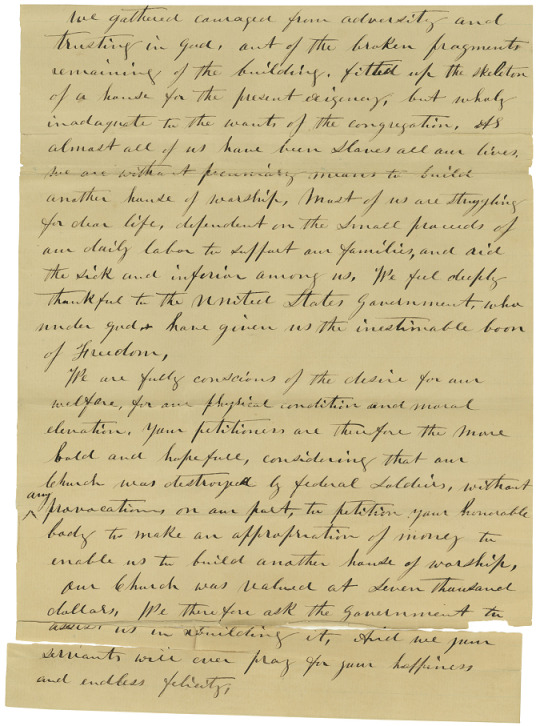

Memorial from African Methodist Episcopal Church of Atlanta, 2/1/1866
“[D]uring the late campaign of General Sherman through Georgia, our house of worship was torn down to the ground, and utterly demolished by a party of Federal Soldiers....We therefore ask the government to assist us in rebuilding it.”
File Unit: Petitions and Memorials, Resolutions of State Legislatures, and Related Documents Which Were Referred to the Committee on Claims during the 39th Congress, 1865 - 1867
Series: Petitions and Memorials, 1793 - 1911
Record Group 233: Records of the U.S. House of Representatives, 1789 - 2015
Transcription:
Atlanta Ga Feb 1st 1866
To the Hon Senate and House Representatives
We your humble Petitioners Freedmen of Atlanta Ga. and members of the Colored Methodist Episcopal Church and a portion of the congregation lately worshiping with Said Church, Beg leave to represent to your honorable body, that during the late campaign of General Sherman through Georgia, our house of worship was torn down to the ground, and utterly demolished by a party of Federal Soldiers.
It was without the least provocation on our part, as we ever demeaned ourselves loyal, and never misused the Federal Soldiers, believing them our best friends.
Your petitioners would state that it was a large, commodious and well [word struck through] finished edifice, that had been built by ourselves when in slavery, our contributions for building were raised by very many hours of severe toil after our daily tasks were done for our Masters, And by denying ourselves many of the comforts of life. It was our crown and joy. It was to us what the temple was to the Jews. When the dark days of war had passed, and we gathered again here from our wonderings, "our holy and beautiful house" was a mass of ruins. Havings no place but under the open canopy of Heaven to publicly worship the God of our fathers,
[page 2]
we gathered courage from adversity and trusting in God, out of the broken fragments remaining of the building, fitted up the skeleton of a house for the present exigency, but wholy inadequate to the wants of the congregation. As almost all of us have been slaves all our lives, we are without pecuniary means to build another house of worship. Most of us are struggling for dear life, dependent on the Small proceeds of our daily labor to support our families, and aid the sick and inferior among us. We feel deeply thankful to the United States Government, who under god have given us the inestimable boon of Freedom.
We fully conscious of the desire for our welfare, for our physical condition and moral elevation. Your petitioners are therefore the more bold and hopeful, considering that our Church was destroyed by federal Soldiers, without any provocation on our part, to petition your honorable body to make an appropriation of money to enable us to build another house of worship. Our Church was valued at Seven thousand dollars. We therefore ask the government to assist us in rebuilding it. And we your servants will ever pray for your happiness and endless felicity.
[page 3]
[In transcribing this page, there seemed to be a difference between the "marks" of the preachers and the rest of the list of petitioners.]
Names of the Preachers
Joseph Wood, Paster in Charge,
S. B. Jones Local Preachers,
N. C. Brown " "
Thomas ✝ Craton " " [on last page has spelling as Crayton]
Arche ✝ Gibbert " "
Douglass ✝ Wilkins " "
John ✝ Geeter " "
Newly ✝ Strickland " "
Ephraim ✝ Russel " "
Perlus? ✝ Murphy " "
Anthony ✝ Mongomery echarter?
Duncan ✝ Minard "
John ✝ Ricks "
Barker ✝ Winship class leader
Green ✝ York " "
Vine ✝ Ware " "
Melsen? ✝ Tinsel " "
John ✝ Roberson
TSam? ✝ Pascar
Stephen ✝ Nearvaud?
Robert ✝ Pearce Henry Bedles, leader,
Preston ✝ Johnson
Daniel? Ellege? Steward
Sam ✝ Swner?
Robert ✝ Webster
Daniel ✝ Macgee
John ✝ Macgee
Nathen ✝ Priar
Charles x Conley Austin x Keith
Andy x Miller Stephen x Gale
Perry x Webster Larry x Thomas
Isaac x Calhoun Lewis x Giles
Jacob Grant Berry x Johnson
Chuck x Mays Ben x Fish
#archivesgov#February 1#1866#1800s#Reconstruction#Atlanta#Georgia#African American history#Black history#African American Methodist Episcopal Church#Colored Methodist Episcopal Church#Civil War#General Sherman
27 notes
·
View notes
Photo
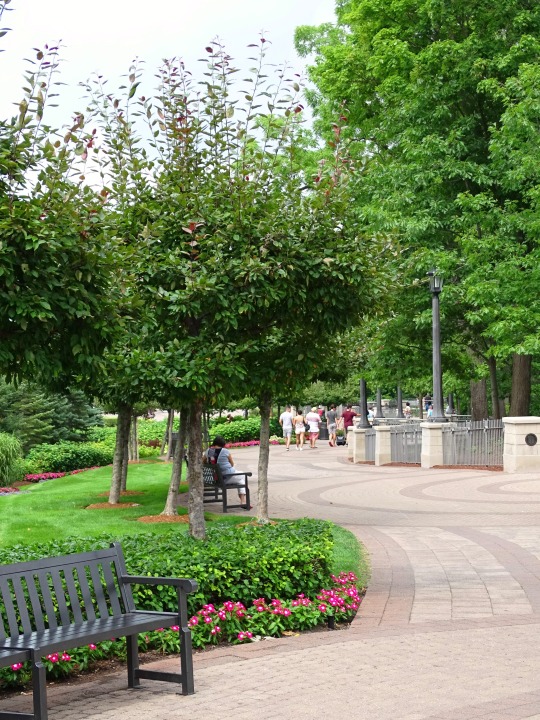






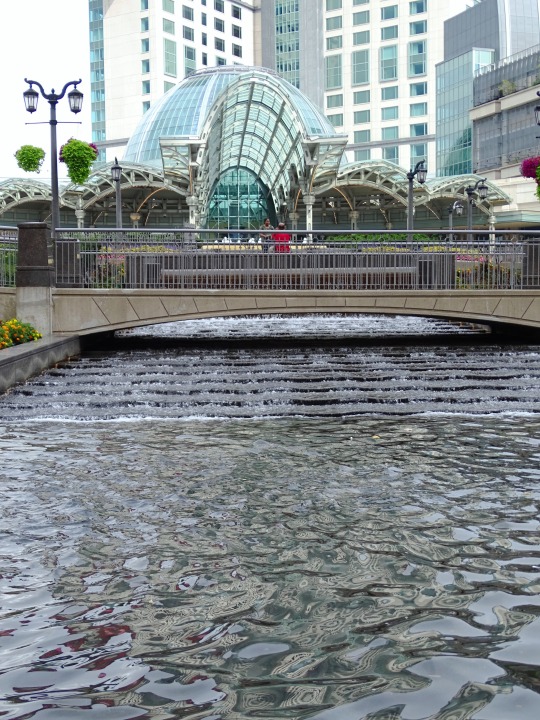
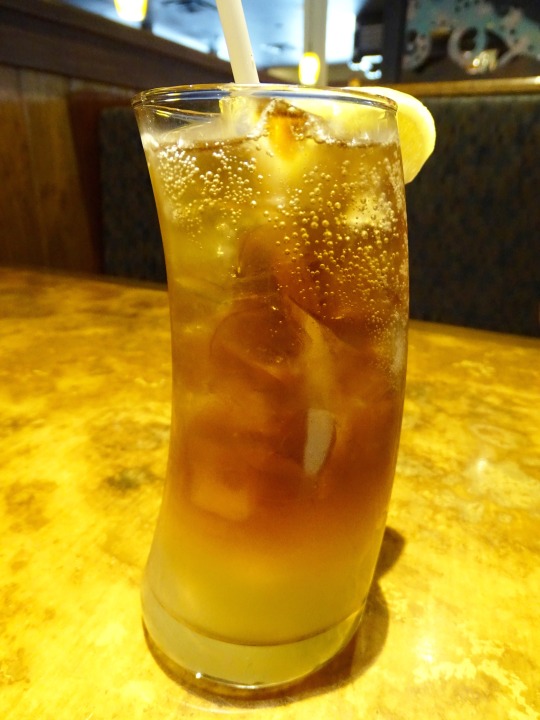

Niagara Falls, ON
Niagara Falls is a city in Ontario. It is on the western bank of the Niagara River in the Golden Horseshoe region of Southern Ontario, with a population of 88,071 at the 2016 census. The municipality was incorporated on 12 June 1903. Across the Niagara River is Niagara Falls, New York. The Niagara River flows over Niagara Falls at this location, creating a natural spectacle which attracts millions of tourists each year.
The tourist area, which stretches along the Niagara Parkway and promenade, is particularly concentrated at the brink of the falls. Apart from the river's natural attractions, it includes observation towers, high-rise hotels, souvenir shops, museums, indoor water parks, casinos and theatres, mostly with colourful neon billboards and advertisements. Farther to the north or south, golf courses are operated alongside historic sites from the War of 1812.
This area was long part of the Iroquois Confederacy territory: five powerful First Nations mostly along the southern edge of the Great Lakes. The Mohawk, Oneida, Onondaga, Cayuga and Seneca were based largely in present-day New York, ranging from east near the Hudson River, to western areas of Seneca Lake and along Ontario and other Great Lakes.
The Niagara Falls area has had some European settlement since the 17th century. Louis Hennepin, a French priest and missionary, is regarded as the first European to visit the area in the 1670s. French colonists settled mostly in Lower Canada, beginning near the Atlantic, and in Quebec and Montreal. After surveys were completed in 1782 the area was referred to as Township Number 2 as well as Mount Dorchester after Guy Carleton, 1st Baron Dorchester (and today is only honoured by Dorchester Road and the community of Dorchester Village). The earliest settlers of Township Number 2 were Philip George Bender (namesake of Bender Street and Bender Hill near Casino Niagara originally from Germany and later New Jersey and Philadelphia) and Thomas McMicken (Scottish born British Army veteran).Increased settlement in this area took place during and after the American Revolutionary War, when the British Crown made land grants to Loyalists to help them resettle in Upper Canada and provide some compensation for their losses after the United States became independent. Loyalist Robert Land received 200 acres (81 ha) and was one of the first people of European descent to settle in the Niagara Region. He moved to nearby Hamilton three years later due to the relentless noise of the falls. In 1791 John Graves Simcoe renamed the town was Stamford after Stamford, Lincolnshire in England but today Stamford is only used for an area northwest of downtown Niagara Falls as well as Stamford Street. During the war of 1812, the battle of Lundy's Lane took place in July 1814, near the town.
In 1856, the Town of Clifton was incorporated. The name of the town was changed to Niagara Falls in 1881. In 1882, the community of Drummondville (near the present-day corner of Lundy's Lane and Main Street) was incorporated as the village of Niagara Falls. The village was referred to as Niagara Falls South to differentiate it from the town. In 1904, the town and village amalgamated to form the City of Niagara Falls. In 1962, the city amalgamated with the surrounding Stamford Township, resulting in a doubling of population. With the creation of a Niagara regional government in 1970, the city absorbed the village of Chippawa, Willoughby Township and part of Crowland Township, creating the present-day municipal boundaries.
Tourism started in the early 19th century and has been a vital part of the local economy since that time. The falls became known as a natural wonder, in part to their being featured in paintings by prominent American artists of the 19th century such as Albert Bierstadt. Such works were reproduced as lithographs, becoming widely distributed. In addition, Niagara Falls markets itself as a honeymoon destination; it is the self-proclaimed "honeymoon capital of the world."
An internment camp was set up at The Armoury in Niagara Falls from December 1914 to August 1918.
The city's official historian is Sherman Zavitz, who gives regular radio broadcasts on many aspects of Niagara's history.
Niagara Falls has had a Black population since at least 1783. Up to 12 African-Americans were a part of the Butler's Rangers, including Richard Pierpoint. When they were disbanded in 1783, they tried to establish themselves through farming nearby, making them among the first Black settlers in the region. It is estimated that nearly 10 percent of the Loyalists to settle in the area were Black Loyalists.
Niagara Fall's Black population increased in the following decades, as a destination on the Underground Railroad. In 1856, a British Methodist Episcopal (BME) Church was established for African-Canadian worshipers. The BME Church, Nathaniel Dett Memorial Chapel is now a National Historic Site, remaining in operation into the 21st century. Composer, organist, pianist and music professor Nathaniel Dett was born in Niagara Falls in 1882.
In 1886, Burr Plato became one of the first African Canadians to be elected to political office, holding the position of City Councillor of Niagara Falls until 1901.
Source: Wikipedia
#Niagara Falls#cityscape#Ontario#Canada#travel#park#nature#landmark#original photography#vacation#summer 2018#flora#flower#blooming#Fallsview Park#architecture#tourist attraction#Fallsview Casino Resort#Black Squirrel#fauna#animal#fountain#lily#Jack's Dundee Tea#don't drink and drive#cocktail
2 notes
·
View notes
Text
Restoring the Historic Stained Glass Windows in Vernon A.M.E. Church in Tulsa
New Post has been published on https://www.denverstainedglass.com/stained-glass-repair/stained-glass-windows-vernon-ame-church-tulsa/
Restoring the Historic Stained Glass Windows in Vernon A.M.E. Church in Tulsa
Located on the corner of Greenwood Avenue and Cameron Street near downtown Tulsa, Oklahoma is one of the oldest and most historically significant buildings in the United States. The Vernon African Methodist Episcopal Church is the only building to have survived one of the worst race massacres in American history and is a visual reminder of the reconstruction process.
On May 31st, it will have been 100 years since this terrible incident occurred. The events which took place on May 31st and June 1st of 1921 resulted in the destruction of a once vibrant and affluent African American community in Tulsa referred to as “Black Wall Street.”
When a mob of angry white people came tearing through the neighborhood, black residents of the community were forced to flee their homes in order to escape the terrible violence. Historians estimate that approximately 300 people were killed and another 10,000 were left homeless.
During this time, some members of the community were able to find safe harbor in the basement of the Vernon A.M.E Church.
Recently, Scottish Stained Glass had the honor of being able to complete the restoration of the historic stained glass windows in the church. Below, we’ve discussed the restoration project in detail.
About the A.M.E. Church
After the 1921 race riots, members of the Vernon A.M.E Church took it upon themselves to rebuild and used for their own funds to pay for the reconstruction. Membership increased over the years and the church assumed a vital role in the community. Today, it provides crucial services to residents who live in the nearby area.
Not only does the church hold regular services for its members and continue to spread its message of hope and resiliency, but it also operates as a sort of food bank, serving meals on a daily basis to the homeless population.
In this way, the church is just as much an important part of Tulsa’s past as it is its present and future.
Restoring the Historic Stained Glass Windows
When the Vernon A.M.E. Church was rebuilt in 1928, a set of stained glass windows were added to the building. Though beautiful, these windows were not protected from the elements with any sort of covering. As a result, they suffered considerable damage over the years from exposure to the elements. There had also been several incidents of vandalism which contributed to the damage.
Recently, the church realized that their stained glass was in need of some repairs and gave us a call. We visited the church in person to determine the condition of the stained glass and whether or not it could be saved.
Upon inspection, we determined that the stained glass could be restored, but it would require a great deal of work. There were approximately 130 panels of stained glass, totaling approximately 5,000 individual glass pieces. Of those pieces, about 700 were broken and/or in need of replacement. The damage was significant, but repairs were possible.
Our Approach
We decided that the best way to approach the repairs was to have new pieces of glass custom made. This way, the replacement pieces would match the historic glass perfectly. We contacted a manufacturer of stained glass who has been in business for 120 years. They were able to determine a formula for the new glass pieces based on the color, density, and texture of the original glass.
While the new glass was being manufactured, we began the process of removing the windows from the church. Normally, we would want to wait until the new glass arrived to commence repairs, but this project had to be completed within a time frame of six months. To save time, we used the original glass to rebuild as many of the windows as we could while we waited for the new glass to arrive.
Fundraising
The stained glass wasn’t the only part of the church that needed repairs. The window frames also needed to be replaced and there were some structural issues in the church that needed to be addressed.
A fundraising campaign was launched to finance the repairs. Several donors contributed to the campaign, many of which chose to remain anonymous. About $1.5 million was raised through fundraising efforts.
Protection & Reinforcement
Once the new glass arrived, we were able to finish the rest of the windows. A local mill company was hired to replace the old window frames which were made of wood and in poor condition.
Once the panels were assembled, we put protective glass over them to guard them from the elements. The protective glass and stained glass windows were made to be the same size so that they could be installed together as a single unit. This way, there would be no additional framing protruding the church. Being able to maintain the original appearance of the church was critical because of its status as a historic building.
New Memorial Stained Glass Window
While most of the historic stained glass windows were able to be repaired, there was one that was missing from the church entirely. Instead of attempting to create a replica from scratch, we decided to create a new window with a completely different design. The window would serve as a memorial to the race massacre which transpired in 1921.
The memorial window was delicately hand-painted by some of our most talented artisans. In the end, the value of this single window was approximately $25,000. However, we decided to donate it to the church for free as a gift from Scottish Stained Glass.
Church Overjoyed with the Results
When we were finished, the church was overjoyed with the results. The premier stained glass company in the country had taken the time to repair their beloved stained glass windows. Not only this, but a beautiful memorial stained glass window had been donated as a gift. The church’s pastor, Robert Turner, was so excited that he actually kissed the stained glass!
Photo Credit: Tulsa World
U.S. Attorney General Merrick Garland also paid the church a visit during his recent trip to Oklahoma.
Currently, there are plans underway to build a museum in the church to memorialize the race massacre.
Learn More
Denver Stained Glass is honored to have been part of the stained glass restoration for the Vernon A.M.E. Church in Tulsa. For more information on this project or our stained glass services, please contact our office.
0 notes
Photo
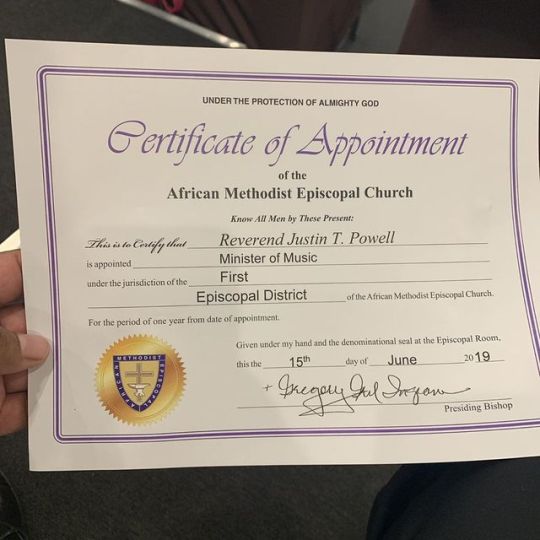
My 4th Appointment as Minister of Music of the 1st Episcopal District of the African Methodist Episcopal Church (at 3801 Market Street First District Plaza) https://www.instagram.com/p/ByvXdh7hbnV/?igshid=1rlh5k52bk7sl
0 notes
Text
2K17 Midwest Road Trip
The weekend of August 11, 2017, I took a road trip with one of my day-1 homies. We go back to 3rd grade Mr. Mule’s class at Washington Elementary School! His family moved to Tennessee when we went to middle school he lives in Memphis, TN now, so we don’t get to connect much. Since we both turned that “30 ball” this year, we decided that it was the perfect time link up for a road trip! I took plenty of pictures and videos during our jaunt - most of which is staying in the vault... BUT, we learned a lot and it would be a crime if I didn’t share some of it.
The route was Memphis, TN - Kansas City (MO & KS) and Omaha, NE. My focus on these road trips is to “do my history” which is Black American history. It seems random, but I chose Omaha because:
It’s the birthplace of Malcolm X, and
there is NO CITY IN AMERICA that black people have not left a lasting impression. Our history is alive all over this country.
The trip was amazing, and I hope you enjoy!
Memphis 8.10.17
I took a 1-way flight to Memphis Thursday night. Made it into town just in time to hit an after work happy hour. This one happened to be on the roof of the Peabody Hotel - a historic hotel downtown. There was a band playing rock music, and I was pleased to hear them do a couple Chuck Berry classics (Berry is a brother from STL that invented Rock N’Roll).
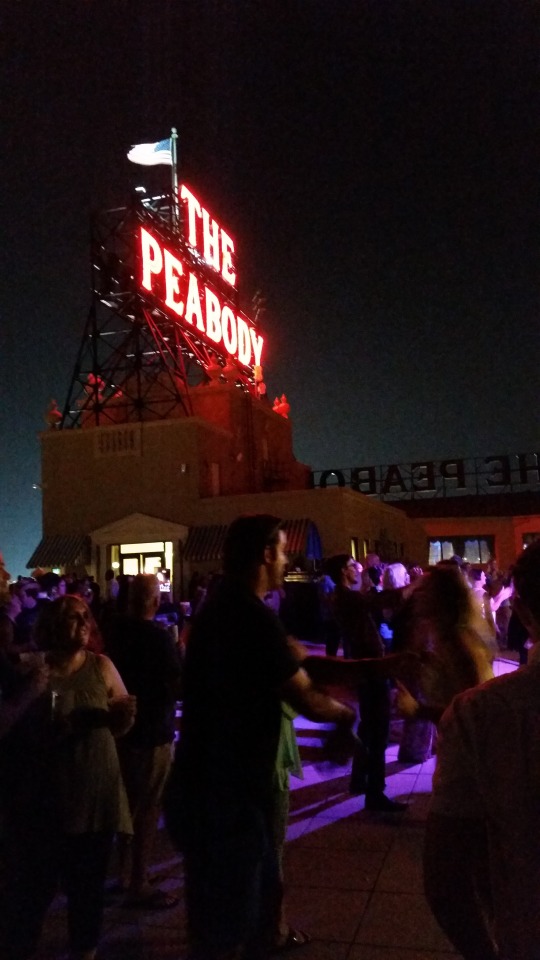
The most amazing part of the night was striking up a conversation with this group of sisters - there were six of them. It started with small talk, and eventually we learned that it was a group of SIX BLACK FEMALE LAWYERS studying at the Univ. of Memphis! They were out celebrating their homegirl’s 30th birthday...real life #BlackGirlMagic. I thought that was dope!
We ended up walking Beale St. for a bit before heading back home to get some rest before the trip.
Kansas City (KS & MO) 8.11.17
We hit the road for KC at about 8:30a (two hours later than planned). After a good 7 hours of driving, we made it to KC. Interesting thing about KC is there are two sides - KC Missouri (which was a slave state) and KC Kansas (a free state). Our first stop was on the Kansas side. We drove straight to a neighborhood just west of the Missouri river called Quindaro.
Quindaro was a boom town started in the 1850s. Since it was right on the river in the free state of Kansas, it eventually became an underground railroad stop for Black people escaping slavery. We visited an overlook structure built at the top of a hill where you could see the Missouri River valley and the trail that people took as they left the river en route to Nebraska - which was the next stop on our trip! An inscription in the overlook described the fight that ensued to preserve Quindaro and keep it from becoming a landfill! It was powerful just being there!
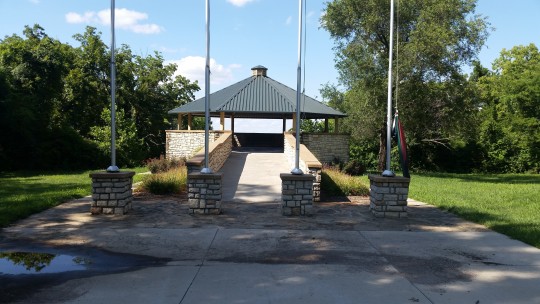
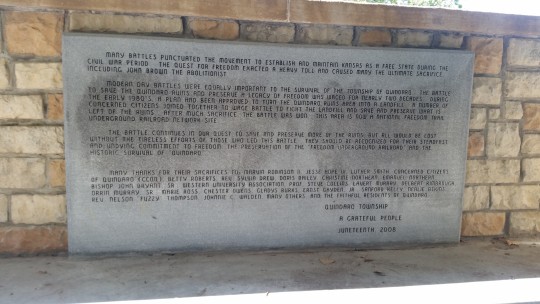
Quindaro was also home to the Quindaro Freedman’s School, which opened during reconstruction after the Civil War. The Freedman’s School eventually grew to become Western University, an HBCU run by the AME church.
In 1911, the AME Bishop granted Western University funds to erect a statue of freedom fighter John Brown on the campus. When we walked down to view the statue, the wildest thing happend. A man named Leo was out walking his five dogs (none of which were on leashes). Leo turned out to be a retired teacher, and he told us all about the statue - as well as Quindaro!
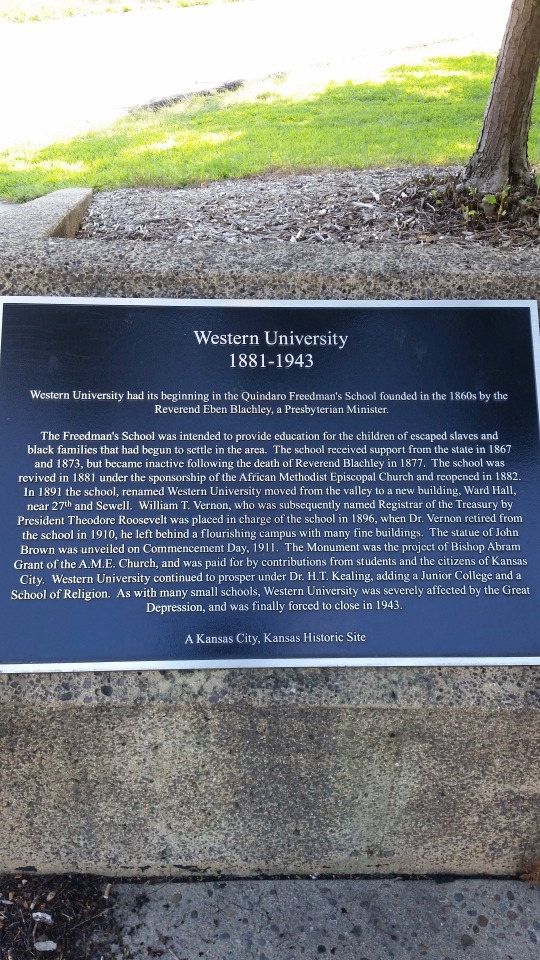

We were crashing with my homie’s family that night. After we left the Quindaro site, we got cleaned up at his people’s crib, and hit the KC Chiefs v. SF 49ers preseason game. The tickets we bought were cheap, which means we got bad seats. We didn’t get to Arrowhead Stadium until the 4th quarter, and by that time, the ushers weren’t really trippin about people moving to different seats. Instead of going up to the nosebleeds, we went down to the field! The down side is, they weren’t selling beer anymore either (they stop selling at the end of the 3rd qtr)...
As far as the game, the Chiefs were pretty much imploding when we got there. We walked in on the 49ers scoring a 2pt conversion to tie the game 17-17. The 9ers went on the score a couple more times and it was a wrap. The stadium atmosphere was amazing though! It was my first time seeing an NFL game!
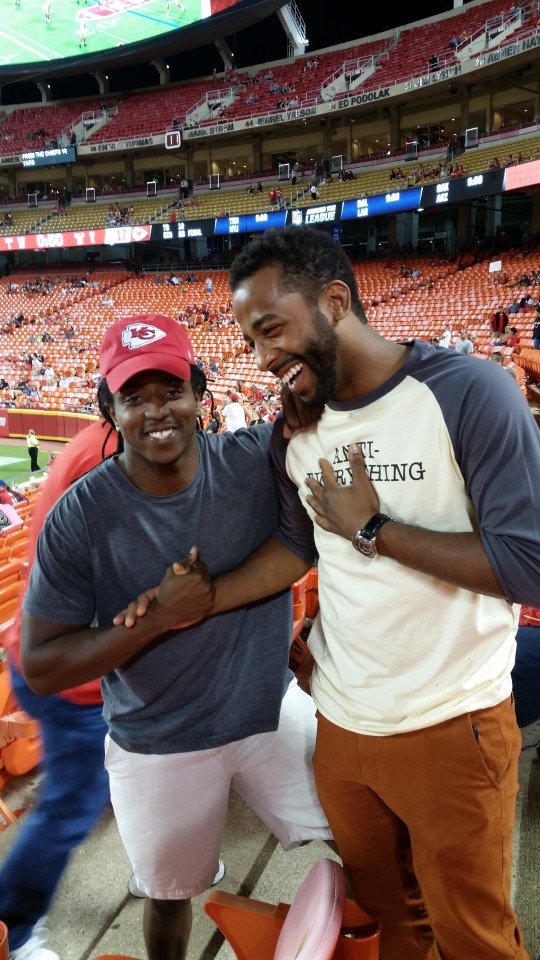
After the game we went downtown KCMO to check out “KC Power & Lights.” It was cool down there, great to see how they redeveloped an old power utility into a performance venue with bars and restaurants.
The next day, we got up and knocked out the 3 hour drive to Omaha, NE.
Omaha, NE 8.12.17
After checking into the hotel, we hit the streets of Omaha. I researched this place called the Great Plains Black History Museum and that was the 1st place we visited. Their original building is in disrepair, and they moved to a retail space at the Crossroads Mall as a temporary show room for some of their artifacts. There was a volunteer on hand named Frank Hayes. He showed us around the space and we ended up having an AMAZING conversation with the brother. Turns out, he’s the founder and principal of Nebraska’s 1st Black owned accounting firm!
http://www.hayes-cpa.com/go/home/
Him and my homie kinda got into a debate because they fall on two seperate ends of the political spectrum, which was hilarious to watch! No pics here, unfortunately.
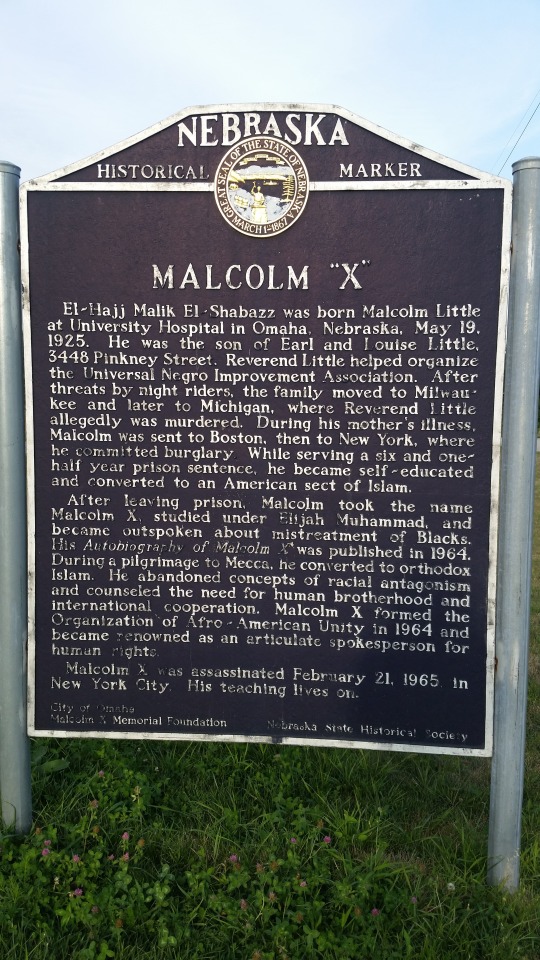
We left the museum and stopped at the site of Malcolm X’s birth home. The house in no longer standing, but there is a foundation named after brother Malcolm that’s developing an 11 acre plot of land into a museum, garden and outdoor amphitheater.
While we were there, another wild thing happened. We ran into a guy named Jed. Jed was from Omaha, but had never visited the Malcolm X site. He said he was a single father that found some free time and decided to stop by. We talked a little about the Autobiography of Malcolm X, and how when Jed read it in college it changed him as an individual. He said that “with everything that happened in Charlottesville today, this is the day I needed to come here.”
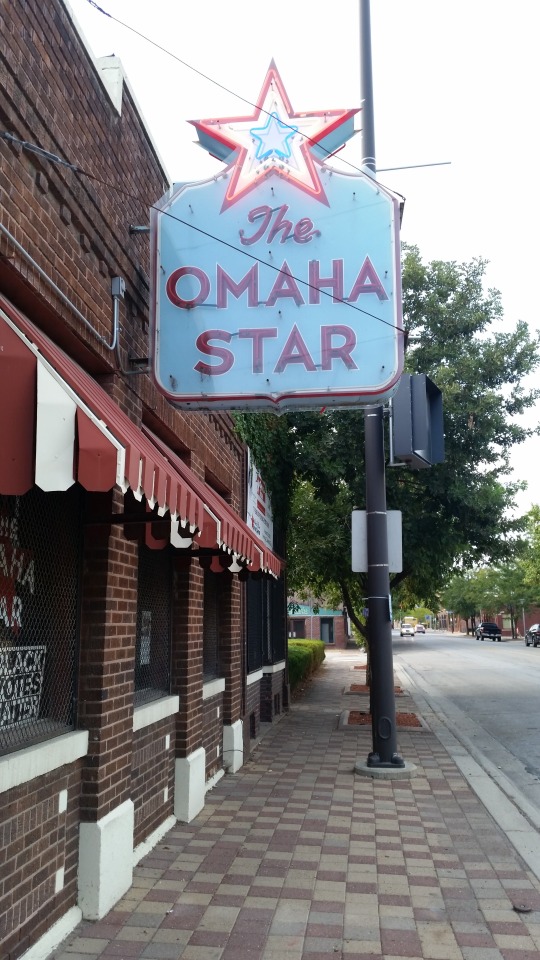
Our next stop was to hit N. 24th St - I wanted to see the Omaha Star building. The Omaha Star is the last black owned newspaper in Nebraska, and one of the only ones left in America! The paper was founded in 1938 by a sister named Mildred Brown! Thought it was significant in the age of FAKE NEWS, that this sister created a media platform for us by us!

Across the street from the Omaha Star was a small blue building with a long awning. There was no real signage, but the front door was open and music was coming out. There was a little sign hanging next to the door stating that NO ONE UNDER 30 YEARS OF AGE IS PERMITTED TO ENTER. Us being two new members of the 30 club, we had to investigate. It turned out to be a sort of juke joint called Jesse’s Place. The brother at the bar carded us immediately. He didn’t quite get the math right on our ages, saying that we were “close enough,” before happily serving us both.
We sat and talked with a couple of older ladies for a bit. I struck up a conversation with a sister named Marilynn Devereaux (last name is pronounced this way, not sure of the exact spelling. She made it clear that her name didn’t have an “A” in it like the white folks lol). Marilynn was happy to learn that we were traveling to connect with Omaha’s Black history. She told us that her family is one of the first three Black families that came to Omaha in 1905. She introduced us to a number of people including Mr. Union, who was in his 80s and a member of another one of the oldest Black families in Omaha. According to Marilynn, he was also thee Gabrielle Union’s great uncle!
Definitely had a great time talking with the OGs at Jesse’s! Here’s a picture of Marilynn below. The sister that took it for us was kinda tipsy:
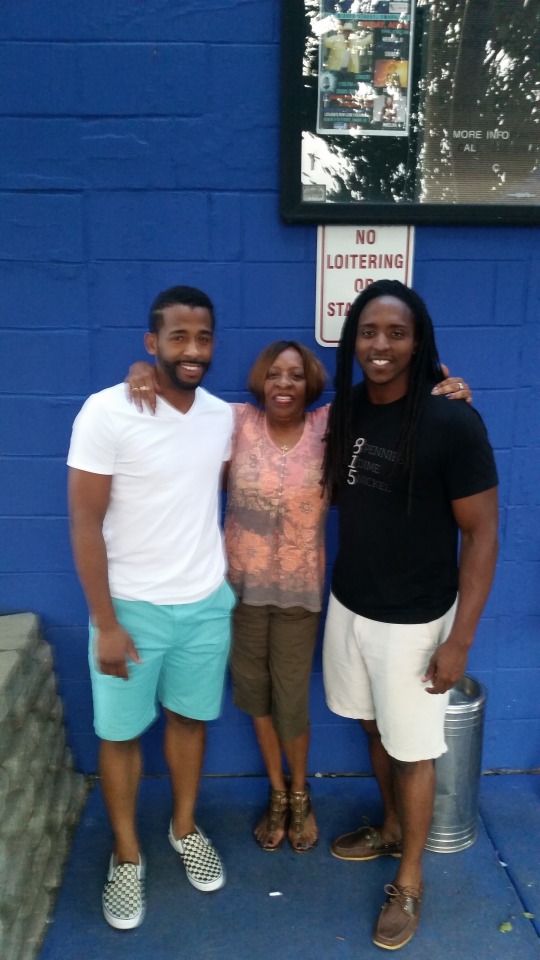
It was already a long day, and I was feeling every bit of my 30 years but we were on a roll! We stopped for food at Time Out Foods for some wings, and headed downtown to Old Market. I learned that this part of downtown Omaha was a former meat packing district that was redeveloped into an entertainment district. There were lots of bars and restaurants to choose from. We found a spot that had a pretty good DJ and kicked it!
Omaha, NE 8.13.17
We got up Sunday and visited St. John African Methodist Episcopal Church, the first black church organized in Omaha! When asked, we stood and introduced ourselves, and were very well received by the congregation. I was impressed and pleased by the minister delivering a message that addressed the Charlottesville terror attack that had taken place the day before!
After service, they served burgers and peach cobbler down in the basement of the church (it was left over from a function they hosted the previous week). I got to talk with some of the elders about the church’s history. One sister gave us a tour of the church’s “history room!”
After church, we hit the highway to end our road trip, headed back to our hometown Rockford, IL.
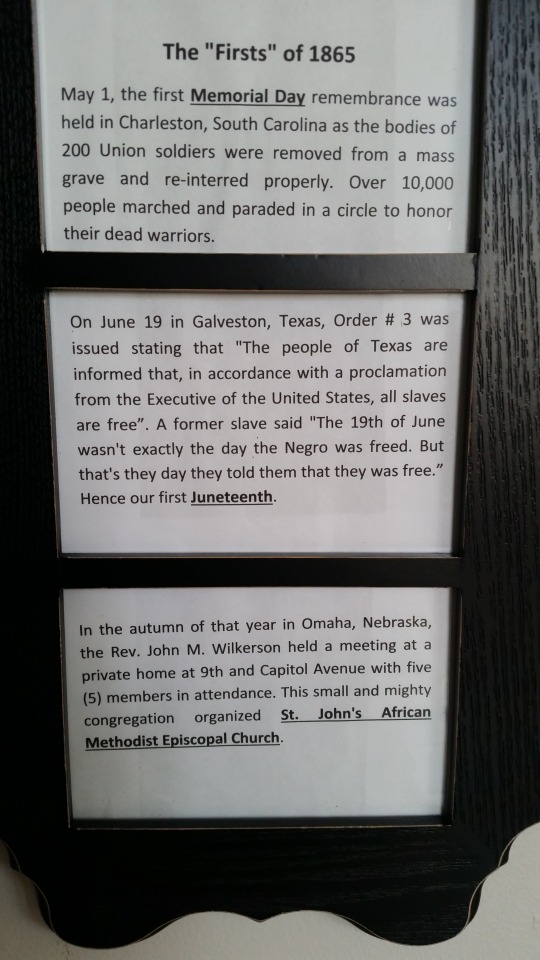

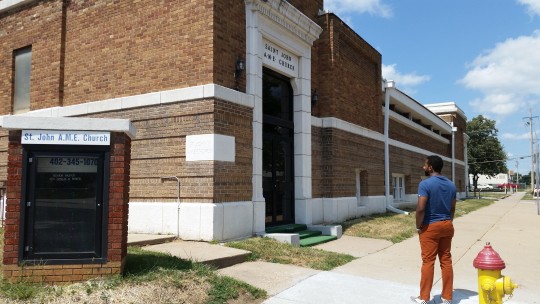
Rockford, IL 8.14.17
I took the day off Monday, but still had A LOT of stuff to take care of back home. One of the biggest things was to do some work for my “W-2 job” (I have about 6 other jobs too lol). I organized a job fair in the Ellis Heights neighborhood (west side Rockford), and needed to do some last minute canvassing ahead of our event. My boy got up and helped me hit the pavement to get the word out about my event! (The pic is him and my sister’s bf)

The weekend was a whirlwind! As dead tired as I was, I enjoyed every minute. It was great learning that rich history - I’m always so motivated by our people and our story! But it was even better getting to reconnect with one of my childhood friends. The midwest road trip is one we’ll never forget!
#friends#brothers#me#roadtrip#memphis#peabody hotel#university of memphis#lawyers#black girls#black girl magic#rooftop#chuck berry#rock and roll#kansas city#kansas city kansas#kc#slavery#quindaro#black history#black american history#american history#western university#quindaro freedmans school#hbcu#ame church#ame#john brown#kansas city chiefs#arrowhead stadium#omaha
2 notes
·
View notes
Text
. GOODREADS BLURB
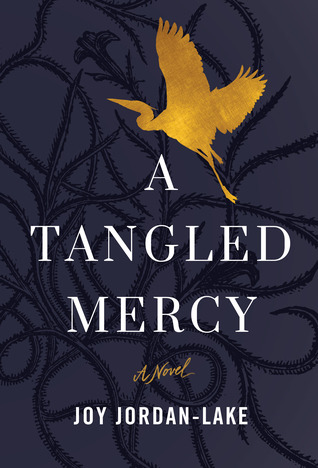
A Tangled Mercy
byJoy Jordan-Lake(Goodreads Author)
4.4 · Rating details · 531 Ratings · 108 Reviews
Told in alternating tales at once haunting and redemptive, A Tangled Mercy is a quintessentially American epic rooted in heartbreaking true events examining the harrowing depths of human brutality and betrayal, and our enduring hope for freedom and forgiveness.
After the sudden death of her troubled mother, struggling Harvard grad student Kate Drayton walks out on her lecture—and her entire New England life. Haunted by unanswered questions and her own uncertain future, she flees to Charleston, South Carolina, the place where her parents met, convinced it holds the key to understanding her fractured family and saving her career in academia. Kate is determined to unearth groundbreaking information on a failed 1822 slave revolt—the subject of her mother’s own research.
Nearly two centuries earlier, Tom Russell, a gifted blacksmith and slave, grappled with a terrible choice: arm the uprising spearheaded by members of the fiercely independent African Methodist Episcopal Church or keep his own neck out of the noose and protect the woman he loves.
Kate’s attempts to discover what drove her mother’s dangerous obsession with Charleston’s tumultuous history are derailed by a horrific massacre in the very same landmark church. In the unimaginable aftermath, Kate discovers a family she never knew existed as the city unites with a powerful message of hope and forgiveness for the world.
(less)
GET A COPY
Amazon
Stores ▾
Libraries
Kindle Edition, 464 pages
Expected publication: November 1st 2017 by Lake Union Publishing
———————————————————————————————————————-
MY REVIEW OF “A TANGLED MERCY” by Joy Jordan-Lake
“A Tangled Mercy” by Joy Jordan-Lake combines the genres of History with Fiction, and Kudos to the author for the vivid descriptions of the charm, spirit, and architecture of Charleston, South Carolina. There are so many contrasts to Charleston in the past and in the present. The timeline of the novel is basically divided into two, weaving the story of the 1822 slave uprising and the 2015 Massacre at Charleston’s at AME Church. This is a very heavy and significant read.
The characters in this novel in both past and present are complex and complicated. Somehow the contrast between good and evil, betrayal and loyalty,love and hate, freedom and oppression seem to be evident in both timelines
Kate Drayton had come to Charleston after her mother’s death to seek answers her mother never gave her. In the process Kate is looking to discover herself. Kate’s mother was obsessed with the 1822 slave revolt and a blacksmith named Tom Russell, a slave. Kate meets a colorful cast of characters, each adding some information for the unanswered questions she is seeking. Kate is a graduate student seeking similar information as her mother to the slave uprising.
We see in the past when Tom Russell was a gifted blacksmith, and how slavery was a part of Charleston’s history. Although Charleston was a port that welcomed people of different religions , it was a tremendous port for slavery. We meet characters that are loyal and those that are betrayers. During this time period there are complicated and conflicted personalities.
Both timelines merge as secrets are discovered and history is revealed. The topic of DNA is brought up and the significance of the research of it. The author shows us that despite hatred and fear, love, hope, trust, and faith is what keeps Charleston. and the people together. In the end, Love, forgiveness, hope and faith will survive. The author also discusses the importance of family, friends, and love.
I recommend this novel for those readers that appreciate fictional characters based on historical facts. I received an Advanced Reading Copy for my honest review.
My Review of “A Tangled Mercy” by Joy Jordan-Lake . GOODREADS BLURB A Tangled Mercy byJoy Jordan-Lake(Goodreads Author) 4.4 · Rating details ·
0 notes
Text
Why Compare the BHI and the KKK?
The latest social media spat within Protestantism surrounds a statement made by the known celebrity apologist Dr. James White involving the BHI and KKK.
The Black Hebrew Israelites (BHI) are a fairly new sect that has developed in the religious world—particularly America. Multiple positions they hold are counter to historic Christian views. Some articulations of their views are nuanced but the primary focus is that Africans and others impacted by the Atlantic slave trade are the true Israel (e.g. "Hebrews") and thus God’s chosen people. They reference Old Testament prophecies to establish this, but after this generic premise, a chasm between different sects arise. For the purpose of this article I will mention the extreme viewpoints of some in this camp:
White people will be slaves and oppressed in New Heavens & New Earth
White people are the Edomites and evil
Other extreme comments can be found regarding violence to white people, who they view as evil. They also believe in observance of the Old Testament laws and thus have a works righteousness dynamic—they oppose any reformation soteriology. There are hardly any connections to of historic orthodox, catholic Christianity.
With many criticisms of doctrine in the camp of the BHI, it remains hard to equate them with the doctrine and historical actions of the KKK. This is what makes Dr. White's comment so historically invalid and reprehensible. I quote:
“These people are racist in a way that make the KKK look like amateurs, in comparison to these guys. They get away with it because they are of a different color and you can be racist if you're that color. But … this is the worst example of using and abusing religion as a cover for racism that you’ll ever see.”
The majority of Dr. James Whites followers have decided to insert the word “today's/modern time” to justify the claim that the BHI has more impact and growth than the KKK/white supremacist in our present communities:
The original statement—“the worst example…that you’ll ever see”—in Dr. White’s quote shows that this is not limited to the current time period, but even if we ignore close to hundreds of years and focus merely on recent history is this claim true? Dr. White highlights the religious tones of the BHI but relatively ignores that the KKK has claimed to be a “Christian” organization throughout its tenure. As recently as 2014, a leader of the Traditionalist American Knights of the KKK argued that they are a “Christian” organization. It is an extreme claim that BHI as a group are the worst example of using and abusing religion as a cover for racism—let alone to the extent of making the KKK seem like amateurs.
Political Examples
In 2015, a radical group that goes by Anonymous released documents outing possible/potential KKK members. This list includes people like Frazier Glenn Miller, convicted of the murder of three people at a Jewish site in Kansas 2014 (still pretty recent). The list has been shown to not be entirely accurate, but it still demonstrates a noticeable KKK present in the United States of America that is unmatched by BHI. Wikipedia has sources for a list of purported—and relatively recent—politicians associated with the KKK:
Robert Byrd, Hugo Black, Edward Jackson, Rice Means, Clarence Morely, Bibb Graves, Clifford Walker, George Gordon, John Tyler Morgan, Edmund Pettus, John Brown Gordon, John Clinton Porter, David Duke, Benjamin F. Stapleton, Warren G. Harding, Harry S. Trueman.
This list includes politicians from the 1920’s until the 1980’s, ending with David Duke, a guy that (poorly) attempted to run for president. Yes, he lost, but to even be considered a possible candidate for president of the United States shows a level of societal influence and impact that no member of the BHI has ever had. President Trueman's (1945) connection to the KKK is not solid, but circumstantial evidence has created a likelihood that he was connected to this domestic terrorist group. Pure numbers show that even with the recent growth of BHI it is nowhere near ingrained in the fabric of American society as the KKK and white supremacist thought.
Recent Examples
On June 17, 2015, a young white male named Dylann Roof entered into a bible study at an African Methodist Episcopal church. He sat there as if genuinely attempting to fellowship with these beloved saints. Ultimately, he shot and killed nine people in that church. Later, reasons for the shooting became known because he confessed a desire to start a race war. Other details have come out showing the murderer posing with symbols of white supremacy and neo-Nazism.
Considering I write this is 2018, I hope this event is not dismissed as out of “today’s context” by people attempting to limit the scope of Dr. White's claims. If the theoretical impact and growth of BHI supposedly exceeds the KKK, I’d expect to hear about the BHI community committing mass genocide or having a serial killer in their midst. As of yet, that is not the case. Yet, it is not a mere theory of a Christian apologist personality that nine funerals were held to lay these saints to rest.
Further, how much actual history do we have to ignore to force a context that makes this statement true? During my lifetime there are multiple examples of terror by the KKK.
On June 7, 1998, James Byrd was murdered by three white supremacists in Jasper, Texas. They dragged his body behind a pickup truck on an asphalt road. What led to this tragedy? Nothing but hate for black people, the same ideology that fuels the KKK. Mr. Byrd accepted a ride home and was murdered. Not just murdered but tortured. They beat him severely, urinated and defecated on him, and chained him by his ankles to their pickup truck before dragging him for approximately 1.5 miles. One of the murderers had a patch that showed his affiliation with a gang of white supremacist known as the Confederate Knights of America. This gang is directly tied to the KKK. For a group that some claim has a lack of influence and decreasing violence in recent decades, examples like these show otherwise.
Similarly, the last recorded lynching by the KKK was in 1981. The lynching of Michael Donald. His body hung from a tree in Mobile, Alabama. No matter what his accused crime was, the United States does not conduct law and order in this manner with no trial taking place. This type of terror has never been attributed to a BHI group.
We can disagree with the BHI's theology and their vile comments, but are we really going to compare words and threats with funeral services and actual death? Even if words are to be compared with actions, there are white supremacist groups that talk just as vile as BHI. It is only a broken logical process that assesses a position which says horrible things as worse than a position that says similar things and has actually fulfilled its threats.
1981 is not so long ago. This lynching happened during my lifetime. Michael Donald was born in 1961 and more than likely he’d still be alive today! The grandmother and grandfather of my kids are still alive and were born around this same time period. How can we state that this reign of terror is not apart of the current context when people born the same year are still alive and active today?
I truly believe the statements made by Dr. White and currently defended vigorously by his supporters are horribly wrong. No matter what spin is put on the statement, it is false and playing off of stereotypes concerning black people in America—the anger and dangerous black male stereotype to be exact. There is no way a verbal threat can be categorized as worst than actual violence. Each example listed in this piece shows actual violence done in the name of white supremacist thought. Even if we limit the scope to say “Dr. White, meant it in today's setting,” we have two murders of people linked back to this thought process (Dylann Roof and Frazier Glenn Miller). We also have the last known lynching being recorded in the lifetime of middle-aged people in America. The only way to prove Dr. White’s claim to be true is to throw out all of history.
Ignore the white supremacists' marches in 2017 and every other example prior to January 1st, 2018, there are still white supremacist groups that say things just as vile and evil as the worst Black Hebrew Israelite quotes. One is left asking why or specifically how this group is defined as the worst! Unfortunately, I can only conclude that this is race baiting at its finest. There is no basis to support Dr. White's comments. He will dig his heels in even more and so will his followers. The fact is that his claims are false.
All of this is similar to how he dug his heels regarding the last racial divisive issue when he grabbed almost every stereotype to apply it to a Black kid that littered and flipped off the cops. (Stereotypes such as “it’s a 70% chance he never met his father,” “he would be the father to kids he will not support,” and other baseless claims.) Calls for repentance were ignored. He simply got support from his favorite black friends to justify his statements and no repentance ever came forth.
To conclude, I’d like to state that the is no way Black Hebrew Israelites are the worst example for using religion as a cover to hide racism. I do not know if Dr. White is a racist or not, but I do know that with a platform as far-reaching as his, I pray he uses his words and accusations more carefully.
0 notes